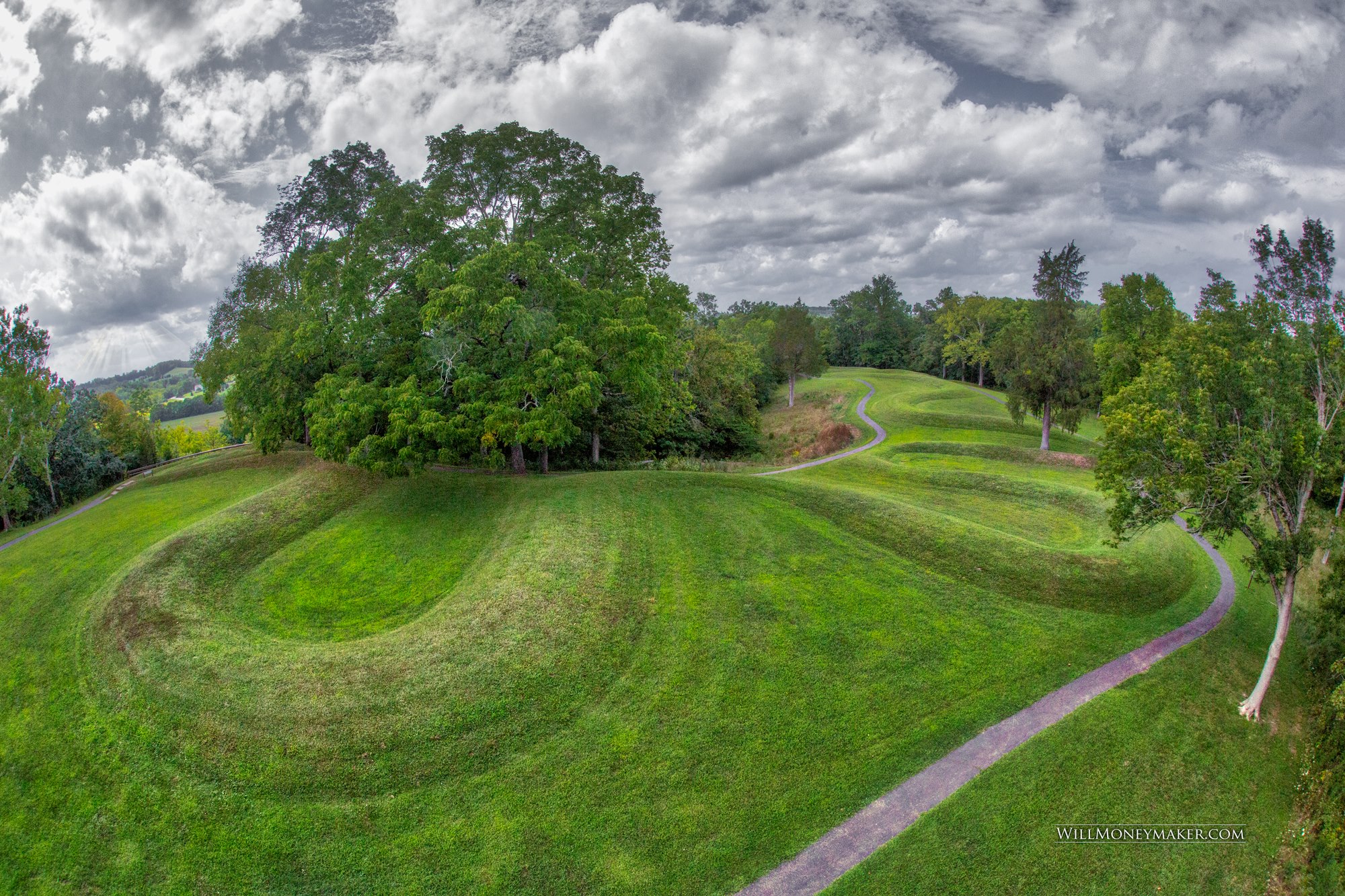Admitted to the union in 1803 as the 17th state, Ohio has one of the longest documented periods of human habitation in North America. The area was inhabited by nomadic ancestors of the later Native Americans. These were the Folsom and Clovis people. It wasn’t until 1,000 BC that a settled culture emerged in Ohio, known as the Adena culture. The Adena culture was able to stay in one place because they domesticated plants, including sunflowers, corn, and squash. The Great Serpent Mound in Adams County, Ohio is part of the Adena culture.

The Great Serpent Mound
The mound-building Mississippian culture came after that, and other, more modern tribes after that. It wasn’t until the 1600’s that Europeans first set foot in Ohio. These were fur trappers. A series of Native American wars among local tribes took place in the 1700s, and the area was a British territory by the mid-1700s. After the Revolution, it became part of the new United States, and eventually a state on its own. Naturally, there is some incredible folklore associated with Ohio. Here are some of the highlights of it.
The Melonheads
The legend of the Melonheads of Lake County, Ohio is an old one, going back generations. Supposedly, if you go out in the woods at night in Lake County, you might see some people with very large heads staring at you out of the tall grass that is common in the area. Some of the earliest tales of the Melonheads talk of them being the ghosts of children who died in a cabin fire.
However, subsequent generations changed the story to the Melonheads being rejected and discarded subjects of government experiments, or the experiments of a rogue scientist. Either way, they are supposedly still out there in the Lake County woods, and local teens often go out there hoping to spot one of them.
The Frogman of Loveland
In 1955, reports in Loveland, Ohio started coming in of sightings of a human/frog hybrid that became known as the Loveland Frog. It was about four feet tall, and witnesses said it waved a wand over its head that sprayed sparks to warn off any passersby. The first reported sighting included not just one Frogman, but a group of them gathered together by the road. While regular locals reported seeing them, some police officers did, too (though they later recanted their stories, likely due to pressure from their employer).
Later sightings of the Loveland Frog included only one creature. It was most recently reported being seen in 2016. At that time, two teens who were playing Pokemon Go reported that they saw a giant frog/human near a lake and that it stood up and walked on its hind legs like a man.
The Grassman of Ohio
Most states have some sort of Bigfoot legend, and Ohio is no exception. In this state, the infamous, publicity-shy monster is called the Grassman. The Grassman of Ohio is said to live around the town of Minerva and is pretty mean-tempered as far as Bigfoots go. Its legend is also older than that of most other North American Bigfoots. While the most famous Bigfoots in the Pacific Northwest have been reported for a few decades at most, the sightings of the Grassman of Ohio go back to pre-European, Native American times.
Ancient Native American lore of a five hundred pound hairy monster that walks on two legs fits perfectly with descriptions from more contemporary sightings of the Grassman. A local family, the Claytons, even say they found human footprints around their home the same day they found their dog with its neck snapped in their yard.
Yes, There is Actually a Helltown, Ohio
Originally known as Boston, Ohio, the town was “decommissioned” when President Gerald Ford turned it over to the National Parks Service in 1974. At the time of the decommissioning, the town was evacuated, and the evacuation was unexpected by the town’s residents. The residents were forced out of the town on a moment’s notice, and most of them had to leave everything they owned behind, including their homes as well as personal items. Some disgruntled evacuees wrote “Now we know how the Indians felt” on the wall of one of the abandoned buildings before they left.
No one knows why the town was evacuated, and the government never said. After the evacuation, the name of the town was officially changed from Boston to Helltown. Rumors began of why the town was evacuated, with tales of ghost children, Satanists, and creepy old men who hid their faces becoming part of the town lore. There is also a supposedly haunted road in Helltown, where spirits try to crash your car if you drive on it. There is a very curvy road going through Helltown, and people sometimes drive out there and crash, sometimes into other thrill-seeking drivers.
The mystery of Helltown still remains, and the town is still an abandoned property of the federal government.
The Ghosts at Cincinnati Music Hall
The Cincinnati Music Hall is probably the most famous landmark in Ohio with a legend associated with it. The story goes that a steamboat exploded in the 1800s in Cincinnati, and the remains of the people who were killed on the boat were scattered all over the city in places where most of them were not supposed to be. Eventually, the remains were collected and deposited in one place together in a field. That field just happens to be where the foundation of the Cincinnati Music Hall was eventually laid.
It was later discovered that even before that, the site of the music hall was a Civil War hospital, and, even earlier, an orphanage (or “orphan asylum,” as they were called back in the day). Naturally, with such a history on this land, the music hall is incredibly haunted. People have reported icy chills in the building, goosebumps rising for apparently no reason, a sense of electricity in the air, and lots of phantom knocking and rapping sounds at any given time in the building.







